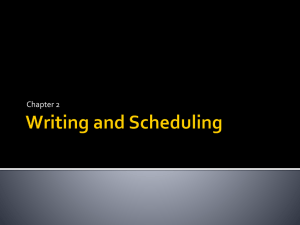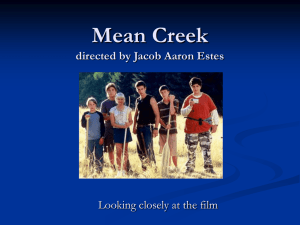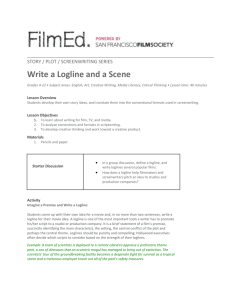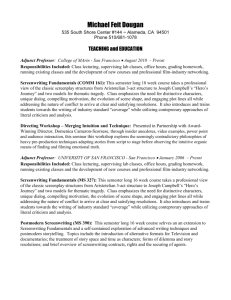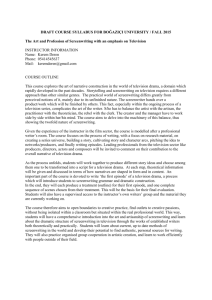Module Outline - University of Warwick
advertisement
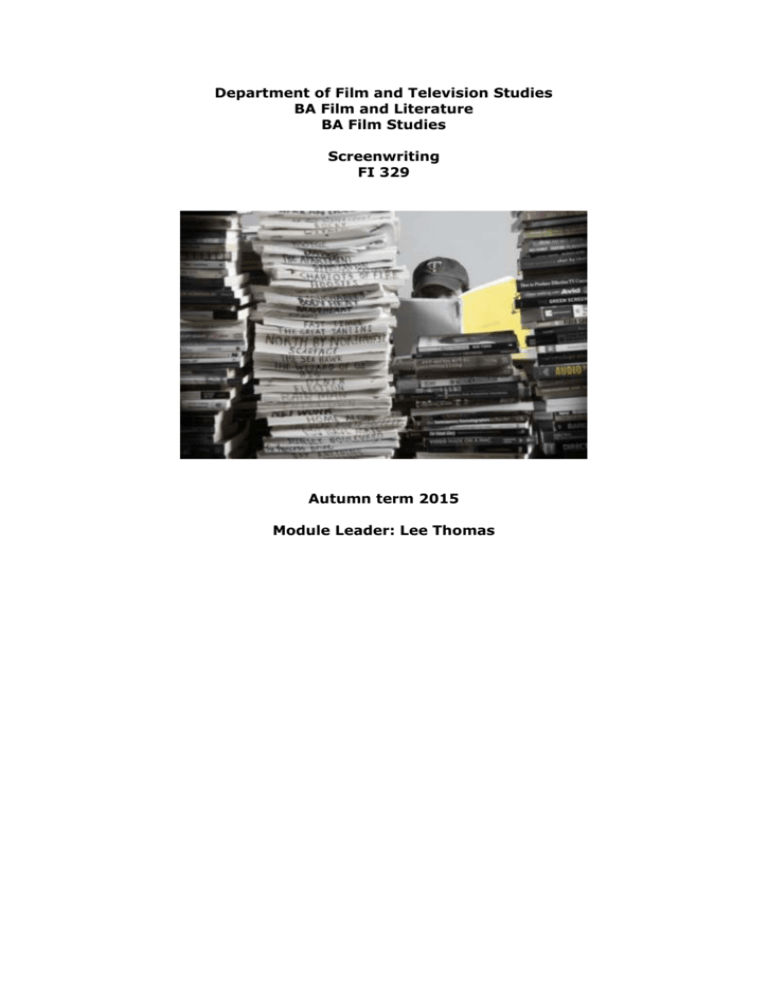
Department of Film and Television Studies BA Film and Literature BA Film Studies Screenwriting FI 329 Autumn term 2015 Module Leader: Lee Thomas Summary This module provides an intensive introduction to screenwriting through a combination of reading, writing, and analytic viewing exercises. The premise of the course is that you can learn the craft of screenwriting, but that the art of it is best mastered through application and practice. The course mainly focuses on film, although discussion and clips may well include television drama. You will discover and explore the basics of how to tell a story for the screen by watching and analysing carefully selected film clips and regular, practical written exercises, which will be discussed in the seminar. Your learning will be enhanced by developing ideas and then writing an assessed short film script (15-20 mins. length). Week by week, you will come to understand and appreciate the critical and functional elements of a screenplay and how different screenwriting tools can be used to dramatically craft a ‘story well told’. No previous knowledge of scriptwriting is required, though focus and engagement with the form is essential. Students will understand the techniques of screenwriting and be able to apply them in their own creative work. Module Aims You will be able to identify and recognise the visual language of dramatic construction, and tell a story through the use of uninflected shots and action. You will be able to demonstrate your understanding of basic dramatic structure by writing a scenario with a defined character (protagonist), and a goal, some obstacles (internal and external) and a resolution. You will be able to identify the various dramatic functions of dialogue in a screenplay, and demonstrate this in your own short film script. You will demonstrate an understanding of characterisation through action. You will be able to identify and understand the uses and potential abuses of foreshadowing, and its usefulness for your own short film script. You will be able to identify and understand how to set up, exploit and pay off a dramatic irony or series of dramatic ironies in your short film script. You will develop the ability to pitch ideas clearly and to condense and marshal ideas into a dramatic step outline form. Timetable Thursdays: screening either 10-12 (A0.26) or 4-6 (A1.25) Fridays: combined lecture and seminar (A1.27) either 9.00-10.30 or 11.00-12.30 (A127) A note on readings Seminar discussion will include close analysis of the required reading - see week by week guide for details. It is essential that you come to the seminar fully prepared. Key Readings will be placed in Short Loan Collection for photocopying and overnight borrowing. Demand for materials is always high so please be considerate to your fellow students. Readings marked * are also available to download at: http://www2.warwick.ac.uk/services/library/search/extracts/fi/fi329 Assessment Formative Writing Exercises in weeks 3 and 5 Draft step outline for discussion in seminar of week 8. Draft opening of the short film script for discussion in seminars of weeks 9 and 10. There will be an opportunity to have individual feedback on drafts directly after the seminars in weeks 8-10. I will be available to give individual feedback on drafts directly after the seminar in Weeks 8-10 in Dr. James MacDowell’s office (A0.17). Summative 1 x step outline for a short film script (30% of the total mark). 1 x 15-20 minute short film script (70% of the total mark). Both pieces are to be submitted by 12.00 on Monday of Week 1 (Spring term) to the Undergraduate Secretary, Dr. Adam Gallimore (Room: A0.12) A step outline is a technical document that some writers / commissioners use to: test the dramatic strengths of an idea; revise and rewrite the story in a shorter more manageable form before writing a complete script It consists of 3-5 pages (for a 15-20 min script) with scene headers and an account of who does what, to whom, and what we learn. It’s about verbs – actions by characters. There is normally no dialogue at this stage. Examples will be provided during the course. A Short Film Script is 15-20 pages of dramatic action written in standard screenplay format (examples to be provided). Usually there will be a clear beginning, middle and an end, with characters we can identify with going through some kind of dramatic experience or journey. The script can be any genre, for live action or animation, and is intended to see how well each student has managed to assimilate the various dramatic constructs and tools explored during the course, WEEK BY WEEK MODULE GUIDE Week 1: Introduction to the key functional elements of a screenplay – writing for the screen. Screening: The Sheep Thief (Asif Kapadia/ 1997) Required Reading: ‘On Storytelling’* (Chapter 1) pp. 1-9 + ‘Countercultural Architecture and Dramatic Structure’ (Chapter 2) pp. 957 in David Mamet On Directing (Harmondsworth: Penguin Books). Themes: Close analysis of a film script in order to appreciate the visual language of dramatic construction. Thinking through how to go about telling a story visually. Week 2: Introduction to dramatic structure and the language of screenwriting Screening: The Elephant Man (David Lynch, 1980). Required Reading: Asif Kapadia’s The Sheep Thief script (copy to be provided) Themes: A look at the 3 act structure and Frank Daniel’s definition of drama as “Somebody wants something badly, and is having difficulty getting it”, and how this relates to Aristotle’s 5 movements of drama. An examination of the difference between objective and subjective drama through clips from key films such as Frenzy (Alfred Hitchcock, 1972), Die Hard (John McTiernan, 1988) Alien (Ridley Scott, 1979) and Ridicule (Patrice Leconte, 1996). Week 3: Managing Conflict: a closer look at protagonist, goals, obstacles and emotions Screening: The Warrior, Asif Kapadia, 2001. Writing Exercise: Write an opening scene with no dialogue which clearly establishes a character who is in some kind of trouble with an external threat. Themes: Building on last week’s session, we will look more closely at Character and Task, and what design and actions make a credible character for film. We will examine the ways in which action defines character. Week 4: Introduction to dialogue Screening: Django Unchained, Quentin Tarantino, 2012 Required Reading: Terri Rossi’s article on “The Task” (http://www.wordplayer.com/columns/wp30.The.Task.html) and reexamine Asif Kapadia’s The Sheep Thief as well as The Warrior’s opening scenes. Themes: Using a variety of key examples from Deliverance (1972), The Doctor (1991), Django, Pulp Fiction (1994), and Blue Jasmine (2013) we will consider the multiple dramatic functions of dialogue: to convey information, develop character, and drive drama. We will also discuss what distinguishes good dialogue from bad and the pitfalls of over-reliance on dialogue in scripts. Week 5: Creating believable worlds: The use of foreshadowing Screening: Amadeus (Milos Forman, 1984). Exercise: Write a dialogue scene (following instructions from previous class). Required Reading: ‘Screenwriting Tools’* in Howard, David and Mabley, Edward. The Tools of Screenwriting: A Writer’s Guide to the Craft and Elements of a Screenplay, St Martin’s Press, NY, 1995, pp. 41-74. Themes: A discussion of key examples taken from Alien, The Apartment (Billy Wilder, 1960), Four O’Clock (Alfred Hitchcock, 1957) in order to consider the major uses of foreshadowing in screenplays. Week 6: READING WEEK There is no formal teaching this week but you are invited to make an appointment for an individual 15-minute tutorial between 9.00 and 12.30 in A1.27 Week 7: Managing Audience Point of view: Dramatic Irony Screening: There’s Something About Mary (Bobby and Peter Farrelly, 1998). Required Reading: ‘Screenwriting Tools’* in Howard, David and Mabley, Edward. The Tools of Screenwriting: A Writer’s Guide to the Craft and Elements of a Screenplay, St Martins Press, NY, 1995, pp. 74-99. Themes: Using clips from key films including The Apartment, There’s Something About Mary and Frenzy, we will discuss diverse ways of setting up, exploiting and paying off dramatic irony. We will also address the pitfalls of the overuse of this technique. Week 8: Pitching short film ideas: the step outline. Screenings: A series of short films including: In My Shoes; Wet & Dry; The Voorman Problem; Inside Out. Writing Exercise: First draft of step outline that will ultimately be submitted for summative assessment. Themes: The focus of this session will be story-TELLING… it will include ideas on how to structure a pitch. You will prepare a first draft of your step outline of a short film and be prepared to share this with others in your seminar. We will cover how to give constructive feedback to a writer and how to receive it from others. You will receive constructive oral feedback from the module leader and from your peers, and will also provide your peers with useful feedback. Week 9: FEEDBACK WEEK Screening: The Apartment (Billy Wilder, 1960). Writing Exercise: First draft of the opening of the short film script that will ultimately be submitted for summative assessment. Themes: You will deliver the draft opening of your short films script to 23 fellow students in advance of the session. Each will read each other’s work and be prepared to ask useful questions about the screenplay during the session. You are encouraged to use the seminar space to discuss any questions arising about your draft or other issues arising with your proposed film script. Week 10: FEEDBACK WEEK Screening: TBC Writing Exercise: First draft of the opening of the short film script that will ultimately be submitted for summative assessment. Themes: This is a continuation of week 9, dealing with any issues that come up and time for Q&A and further discussion. Reading List Core Reading: There are many and varied 'how-to' guides about the process of screenwriting, but reading a wide range of scripts and watching a diverse range of films will offer you a broader, more instinctive understanding of the craft. That said, these foundational texts will provide a useful technical understanding to build on. All titles listed on this page are stocked in the university library and copies will be made available in the Short Loan Collection. Field, Syd. Screenplay: The Foundations of Screenwriting, (Third Edition), Bantam Doubleday Bell, 1998. Howard, David and Mabley, Edward. The Tools of Screenwriting: A Writer’s Guide to the Craft and Elements of a Screenplay, St Martins Press, NY, 1995) Mamet, David. On Directing, (ISBN: 9780140127225 Penguin Books Ltd; Reprint edition) Scher, Lucy. Reading Screenplays, Creative Essentials, 2011. Additional Reading: These titles offer interesting and useful broader frames of reference for your screenwriting and can also inform your developing responses to the aesthetics of film. How you watch a film can play its part in how you write a screenplay. Aristotle. Poetics, Penguin Classics, 1996. Goldman, William. Adventures In The Screen Trade: A Personal View of Hollywood, 1983. King, Stephen. On Writing: A Memoir of the Craft, Hodder & Stoughton, 2000.

